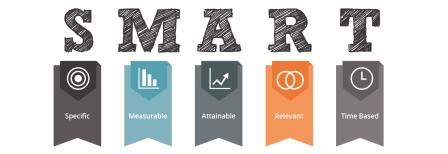Part of the strategy of developing an effective PR or marketing communication campaign is to articulate a cohesive set of desired outcomes: positioning, goals, and objectives; these, in turn, allow managers to plan and implement strategic campaigns.
Objectives should be measurable and clear, so that you can see when you’ve met or exceeded them. PR objectives can and should be specified in terms of audience (who is the best target?), time frame (when should the program begin and end?), and outcomes, which may be further reflected in terms that are behavioral (did they do what we wanted them to do?), attitudinal (do they feel about us what we wanted them to feel?), and informational (do they know about us what we want them to know?).
A S.M.A.R.T. objective is more likely to succeed because it is clear or specific, so you know exactly what needs to be achieved. You can tell when it has been achieved, if it is measurable, because you have a way to measure the impact.
You have to know what you’re measuring, before you can effectively measure the results or Return On Investment (ROI) of your Public Relations programmes. If you study some good PR plans, you will notice that they consistently have well-worked out goals and objectives.
If you are really interested in improving the performance of your Public Relations programmes, then it’s important that you work at getting S.M.A.R.T. with your objective definition. It’s more than relevant and is applicable to public relations strategy and planning. To recall what the acronym S.M.A.R.T. stands for, it’s –
S = Specific
M = Measurable
A = Actionable
R = Realistic
T = Time-based
Here’s a quick look at what the acronym S.M.A.R.T. signifies, for PR planning:
- Specific
If the communication objective is clearly defined, ie if it’s specific, then it is easy for everybody to know exactly what you are trying to accomplish in PR. Possible communications objectives include – creating awareness, imparting knowledge, projecting favourable reputation, shaping attitudes and so on.
- Measurable
Breaking your PR strategy into components during the planning process will make it easier to measure outcomes and set target goals. Can you measure your progress against the objective with relative ease? Is the planned activity directly tied to that objective? You can, and you may want to be more specific and report on an activity specific to the objective, so that you can measure the impact. If you don’t know how you will measure your objective, you need to work around the definition!
- Actionable or attainable
Is the objective action-oriented to lead to improved performance? If the objective doesn’t enhance corporate reputation, there is little point in it! You should be able to complete your objectives within a reasonable amount of time. If your objective is too far in the future, or too complex, then it’s advisable to break it down to a shorter-term objective. So, take care to develop and articulate in clear terms strategic actionable objectives/goals which should be specific and measurable. These should definitely provide an indicator of success.
- Realistic or relevant
Can the information be applied to the specific problem faced by the marketer? Be honest with your objective setting. While you may want to be aggressive, you also need to be realistic about what you can achieve by your project deadline. Consider asking all important questions when setting an objective. If you have available data on current or past performance, use that as a guide. For example, if you increased website traffic by 25% last year, can you increase by 35% this year? If you set and measure against S.M.A.R.T. objectives, you’ll get more accurate with your forecasting in the future.
- Time-based
Can objectives be set for different time periods as targets to review against? Your objective should be closely tied to a date (or time). The more specific you can be with this deadline, the better. That makes you work towards a specific deadline. Often, there may be a big gap between when you think you can complete a task and when it actually gets done.
It may help to use any project management system that your firm has. It can enable you to track tasks or milestones. And, keep you on the moving track!
Getting started NOW!
Do you have your objectives defined? Review your current goals for Q1 or 201 7. Check out, how they hold up to the S.M.A.R.T. test? If you discover, there are gaps and that objectives need to be reworked, it’s not too late! You can revise them now – to be more specific, measurable, actionable, realistic and time-based.






Leave a comment